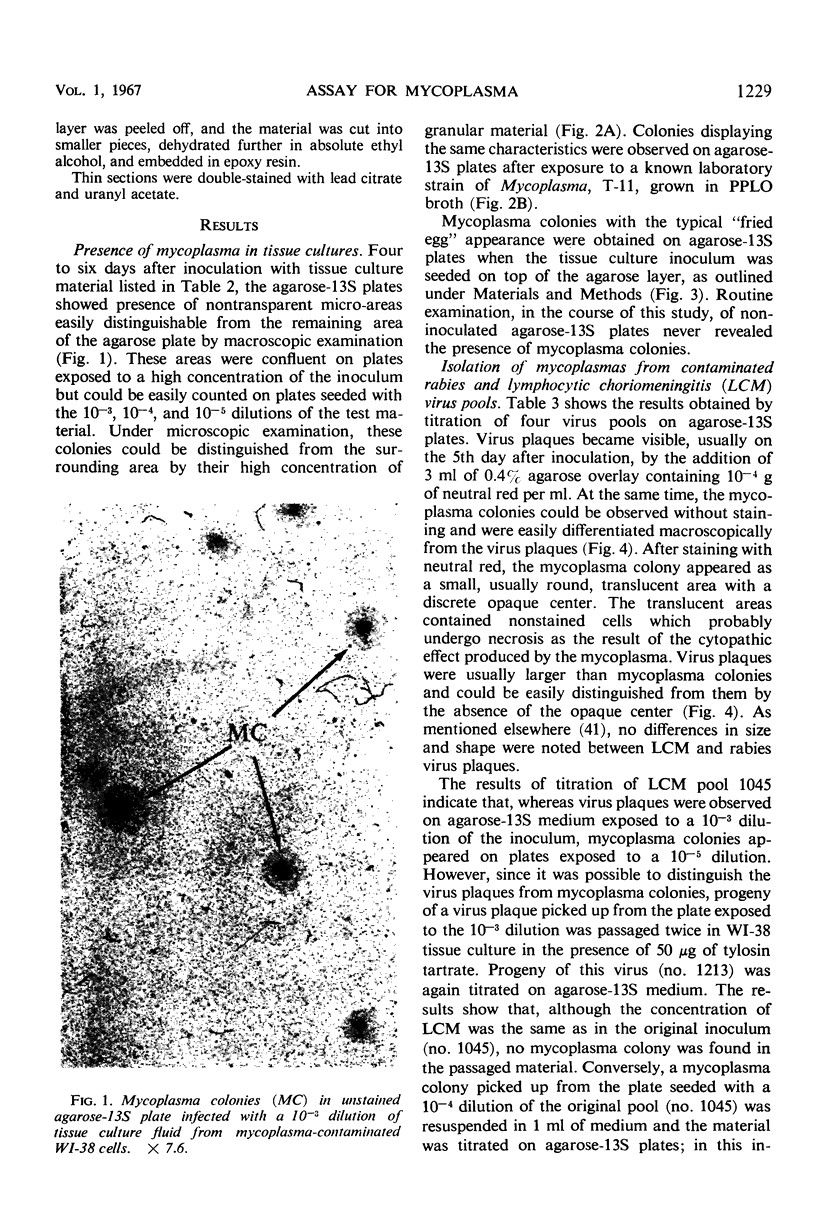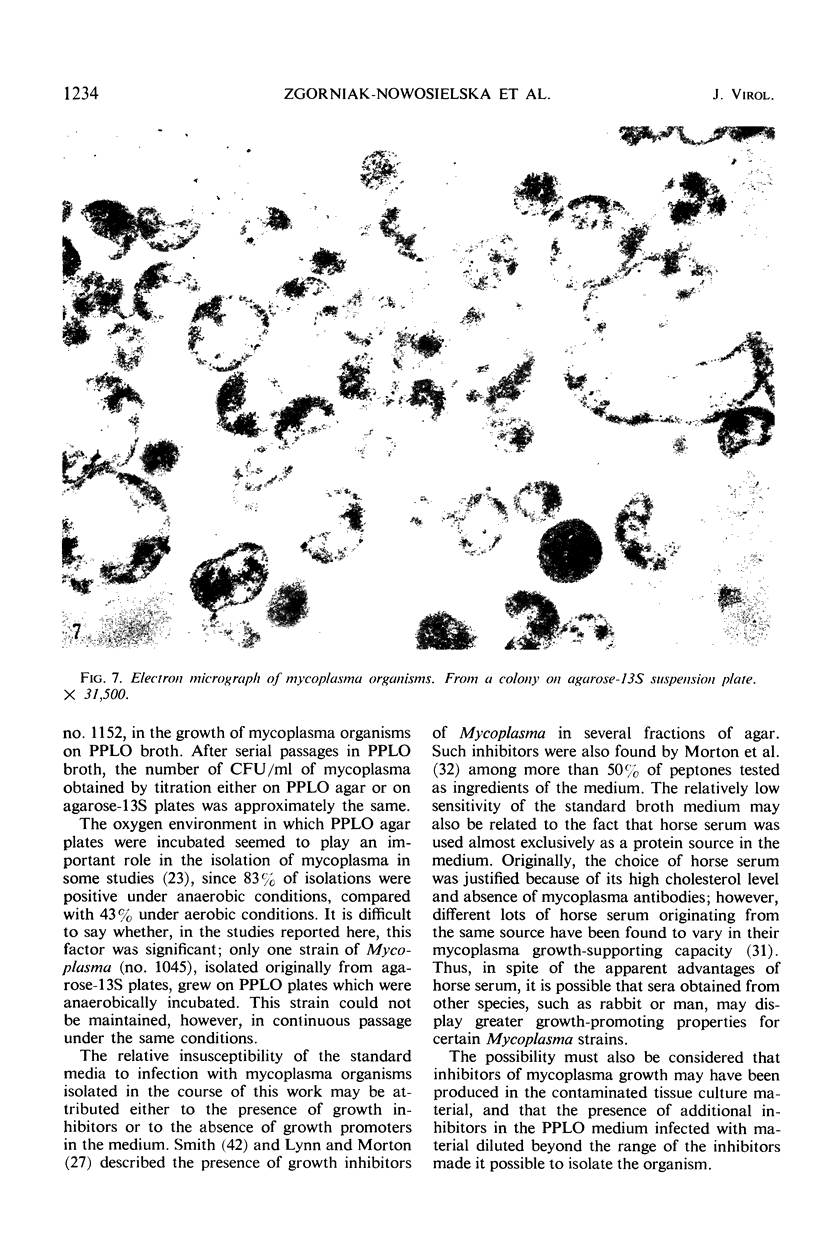Abstract
Presence of mycoplasma organisms in tissue culture systems and virus pools was detected by titration of the contaminated material on agarose-suspended BHK21/13S cells. The use of this method permitted isolation of mycoplasmas which could not be detected by standard assay methods. Mycoplasma colonies at concentrations ranging from 104 to 106 colony-forming units/ml in agarose-BHK21/13S media could be distinguished from virus plaques, and the two populations of microorganisms could be easily disassociated either by electron microscopy or by biological methods. All isolated mycoplasmas were identified in growth inhibition tests as belonging to the GDL group. The growth inhibition test on agarose-BHK21/13S cell suspension plates could also be applied directly to those strains which could not be isolated by standard assay procedures.
Full text
PDF










Images in this article
Selected References
These references are in PubMed. This may not be the complete list of references from this article.
- ARMSTRONG D., HENLE G., SOMERSON N. L., HAYFLICK L. CYTOPATHOGENIC MYCOPLASMAS ASSOCIATED WITH TWO HUMAN TUMORS. I. ISOLATION AND BIOLOGICAL ASPECTS. J Bacteriol. 1965 Aug;90:418–424. doi: 10.1128/jb.90.2.418-424.1965. [DOI] [PMC free article] [PubMed] [Google Scholar]
- BUTLER M., LEACH R. H. A MYCOPLASMA WHICH INDUCES ACIDITY AND CYTOPATHIC EFFECT IN TISSUE CULTURE. J Gen Microbiol. 1964 Feb;34:285–294. doi: 10.1099/00221287-34-2-285. [DOI] [PubMed] [Google Scholar]
- CARSKI T. R., SHEPARD C. C. Pleuropneumonia-like (mycoplasma) infections of tissue culture. J Bacteriol. 1961 Apr;81:626–635. doi: 10.1128/jb.81.4.626-635.1961. [DOI] [PMC free article] [PubMed] [Google Scholar]
- CLYDE W. A., Jr MYCOPLASMA SPECIES IDENTIFICATION BASED UPON GROWTH INHIBITION BY SPECIFIC ANTISERA. J Immunol. 1964 Jun;92:958–965. [PubMed] [Google Scholar]
- COLLIER L. H. Contamination of stock lines of human carcinoma cells by pleuropneumonia-like organisms. Nature. 1957 Oct 12;180(4589):757–758. doi: 10.1038/180757a0. [DOI] [PubMed] [Google Scholar]
- CORIELL L. L., FABRIZIO D. P., WILSON S. R. Comparison of PPLO strains from tissue culture by complement fixation. Ann N Y Acad Sci. 1960 Jan 15;79:574–580. doi: 10.1111/j.1749-6632.1960.tb42726.x. [DOI] [PubMed] [Google Scholar]
- CORIELL L. L., TALL M. G., GASKILL H. Common antigens in tissue culture cell lines. Science. 1958 Jul 25;128(3317):198–199. doi: 10.1126/science.128.3317.198. [DOI] [PubMed] [Google Scholar]
- FOGH J., FOGH H. CHROMOSOME CHANGES IN PPLO-INFECTED FL HUMAN AMNION CELLS. Proc Soc Exp Biol Med. 1965 May;119:233–238. doi: 10.3181/00379727-119-30145. [DOI] [PubMed] [Google Scholar]
- Girardi A. J., Hamparian V. V., Somerson N. L., Hayflick L. Mycoplasma isolates from primary cell cultures and human diploid cell strains. Proc Soc Exp Biol Med. 1965 Dec;120(3):760–770. doi: 10.3181/00379727-120-30649. [DOI] [PubMed] [Google Scholar]
- HAKALA M. T., HOLLAND J. F., HOROSZEWICZ J. S. Change in pyrimidine deoxyribonucleoside metabolism in cell culture caused by Mycoplasma (PPLO) contamination. Biochem Biophys Res Commun. 1963 Jun 20;11:466–471. doi: 10.1016/0006-291x(63)90094-9. [DOI] [PubMed] [Google Scholar]
- HAYFLICK L. THE LIMITED IN VITRO LIFETIME OF HUMAN DIPLOID CELL STRAINS. Exp Cell Res. 1965 Mar;37:614–636. doi: 10.1016/0014-4827(65)90211-9. [DOI] [PubMed] [Google Scholar]
- HAYFLICK L. THE MYCOPLASMA (PPLO) SPECIES OF MAN. Trans N Y Acad Sci. 1965 May;27:817–827. doi: 10.1111/j.2164-0947.1965.tb02241.x. [DOI] [PubMed] [Google Scholar]
- HUMMELER K., ARMSTRONG D., TOMASSINI N. CYTOPATHOGENIC MYCOPLASMAS ASSOCIATED WITH TWO HUMAN TUMORS. II. MORPHOLOGICAL ASPECTS. J Bacteriol. 1965 Aug;90:511–516. doi: 10.1128/jb.90.2.511-516.1965. [DOI] [PMC free article] [PubMed] [Google Scholar]
- HUMMELER K., TOMASSINI N., HAYFLICK L. ULTRASTRUCTURE OF A MYCOPLASMA (NEGRONI) ISOLATED FROM HUMAN LEUKEMIA. J Bacteriol. 1965 Aug;90:517–523. doi: 10.1128/jb.90.2.517-523.1965. [DOI] [PMC free article] [PubMed] [Google Scholar]
- Hayflick L., Stanbridge E. Isolation and identification of mycoplasma from human clinical materials. Ann N Y Acad Sci. 1967 Jul 28;143(1):608–621. doi: 10.1111/j.1749-6632.1967.tb27705.x. [DOI] [PubMed] [Google Scholar]
- Hayflick L. Tissue cultures and mycoplasmas. Tex Rep Biol Med. 1965 Jun;23(Suppl):285+–285+. [PubMed] [Google Scholar]
- Hummeler K., Koprowski H., Wiktor T. J. Structure and development of rabies virus in tissue culture. J Virol. 1967 Feb;1(1):152–170. doi: 10.1128/jvi.1.1.152-170.1967. [DOI] [PMC free article] [PubMed] [Google Scholar]
- KANDA Y., MELNICK J. L. In vitro differentiation of virulent and attenuated polioviruses by their growth characteristics on MS cells. J Exp Med. 1959 Jan 1;109(1):9–24. doi: 10.1084/jem.109.1.9. [DOI] [PMC free article] [PubMed] [Google Scholar]
- LEMCKE R. M. A SEROLOGICAL COMPARISON OF VARIOUS SPECIES OF MYCOPLASMA BY AN AGAR GEL DOUBLE-DIFFUSION TECHNIQUE. J Gen Microbiol. 1965 Jan;38:91–100. doi: 10.1099/00221287-38-1-91. [DOI] [PubMed] [Google Scholar]
- LEMCKE R. M. THE RELATIONSHIP OF A TYPE OF MYCOPLASMA ISOLATED FROM TISSUE CULTURES TO A NEW HUMAN ORAL MYCOPLASMA. J Hyg (Lond) 1964 Sep;62:351–352. doi: 10.1017/s0022172400040067. [DOI] [PMC free article] [PubMed] [Google Scholar]
- LEMCKE R. M. THE SEROLOGICAL DIFFERENTIATION OF MYCOPLASMA STRAINS (PLEURO-PNEUMONIA-LIKE ORGANISMS) FROM VARIOUS SOURCES. J Hyg (Lond) 1964 Jun;62:199–219. doi: 10.1017/s0022172400039930. [DOI] [PMC free article] [PubMed] [Google Scholar]
- LYNN R. J., MORTON H. E. The inhibitory action of agar on certain strains of pleuropneumonia-like organisms. Appl Microbiol. 1956 Nov;4(6):339–341. doi: 10.1128/am.4.6.339-341.1956. [DOI] [PMC free article] [PubMed] [Google Scholar]
- MACPHERSON I., STOKER M. Polyoma transformation of hamster cell clones--an investigation of genetic factors affecting cell competence. Virology. 1962 Feb;16:147–151. doi: 10.1016/0042-6822(62)90290-8. [DOI] [PubMed] [Google Scholar]
- MCCARTY K. S., WOODSON B., AMSTEY M., BROWN O. ARGININE AS A PRECURSOR OF PYRIMIDINES IN STRAIN L-929 FIBROBLASTS INFECTED WITH PLEUROPNEUMONIA-LIKE ORGANISMS. J Biol Chem. 1964 Feb;239:544–549. [PubMed] [Google Scholar]
- MORTON H. E., SMITH P. F., LEBERMAN P. R. Investigation of the cultivation of pleuropneumonia-like organisms from man. Am J Syph Gonorrhea Vener Dis. 1951 Jul;35(4):361–369. [PubMed] [Google Scholar]
- Morton H. E., Roberts R. J. Production of anti-Mycoplasma (PPLO) antibodies in rabbits. Proc Soc Exp Biol Med. 1967 Jun;125(2):538–543. doi: 10.3181/00379727-125-32140. [DOI] [PubMed] [Google Scholar]
- Morton H. E., Roberts R. J. Propagation of mycoplasma other than M. pneumoniae. Ann N Y Acad Sci. 1967 Jul 28;143(1):366–374. doi: 10.1111/j.1749-6632.1967.tb27678.x. [DOI] [PubMed] [Google Scholar]
- Nardone R. M., Todd J., Gonzalez P., Gaffney E. V. Nucleoside incorporation into strain L cells: inhibition by pleuropneumonia-like organisms. Science. 1965 Sep 3;149(3688):1100–1101. doi: 10.1126/science.149.3688.1100. [DOI] [PubMed] [Google Scholar]
- O'CONNELL R. C., WITTLER R. G., FABER J. E. AEROSOLS AS A SOURCE OF WIDESPREAD MYCOPLASMA CONTAMINATION OF TISSUE CULTURES. Appl Microbiol. 1964 Jul;12:337–342. doi: 10.1128/am.12.4.337-342.1964. [DOI] [PMC free article] [PubMed] [Google Scholar]
- POWELSON D. M. Metabolism of animal cells infected with mycoplasma. J Bacteriol. 1961 Aug;82:288–297. doi: 10.1128/jb.82.2.288-297.1961. [DOI] [PMC free article] [PubMed] [Google Scholar]
- ROBINSON L. B., WICHELHAUSEN R. H. Contamination of human cell cultures by pleuropneumonialike organisms. Science. 1956 Dec 7;124(3232):1147–1148. doi: 10.1126/science.124.3232.1147. [DOI] [PubMed] [Google Scholar]
- ROTHBLAT G. H. PPLO contamination in tissue cultures. Ann N Y Acad Sci. 1960 Jan 15;79:430–432. doi: 10.1111/j.1749-6632.1960.tb42708.x. [DOI] [PubMed] [Google Scholar]
- Randall C. C., Gafford L. G., Gentry G. A., Lawson L. A. Lability of host-cell DNA in growing cell cultures due to Mycoplasma. Science. 1965 Sep 3;149(3688):1098–1099. doi: 10.1126/science.149.3688.1098. [DOI] [PubMed] [Google Scholar]
- SCHIMKE R. T., BARILE M. F. ARGININE METABOLISM IN PLEUROPNEUMONIA-LIKE ORGANISMS ISOLATED FROM MAMMALIAN CELL CULTURE. J Bacteriol. 1963 Aug;86:195–206. doi: 10.1128/jb.86.2.195-206.1963. [DOI] [PMC free article] [PubMed] [Google Scholar]
- SCHIMKE R. T., BARILE M. F. Arginine breakdown in mammalian cell culture contaminated with pleuropneumonia-like organisms (PPLO). Exp Cell Res. 1963 May;30:593–596. doi: 10.1016/0014-4827(63)90337-9. [DOI] [PubMed] [Google Scholar]
- SMITH P. F. Synthetic media for pleuropneumonialike organisms. Proc Soc Exp Biol Med. 1955 Apr;88(4):628–631. doi: 10.3181/00379727-88-21675. [DOI] [PubMed] [Google Scholar]
- STOKER M., MACPHERSON I. SYRIAN HAMSTER FIBROBLAST CELL LINE BHK21 AND ITS DERIVATIVES. Nature. 1964 Sep 26;203:1355–1357. doi: 10.1038/2031355a0. [DOI] [PubMed] [Google Scholar]
- Sedwick W. D., Wiktor T. J. Reproducible plaquing system for rabies, lymphocytic choriomeningitis,k and other ribonucleic acid viruses in BHK-21-13S agarose suspensions. J Virol. 1967 Dec;1(6):1224–1226. doi: 10.1128/jvi.1.6.1224-1226.1967. [DOI] [PMC free article] [PubMed] [Google Scholar]
- Vaheri A., Sedwick W. D., Plotkin S. A. Growth of rubella virus in BHK21 cells. II. Enhancing effect of DEAE-dextran, semicarbazide and low doses of metabolic inhibitors. Proc Soc Exp Biol Med. 1967 Aug-Sep;125(4):1092–1098. doi: 10.3181/00379727-125-32284. [DOI] [PubMed] [Google Scholar]










